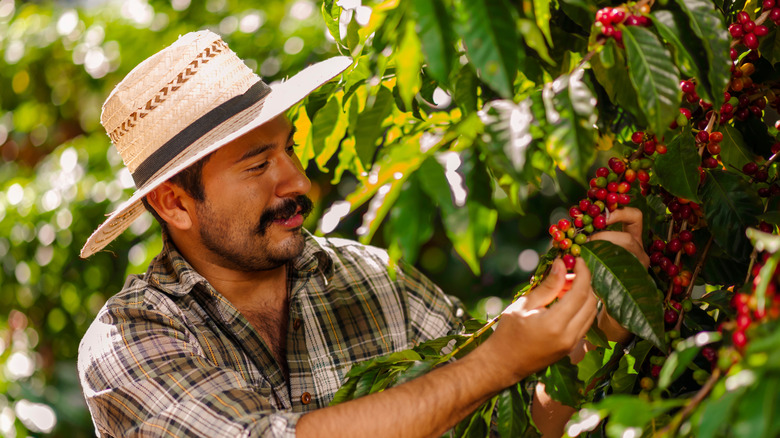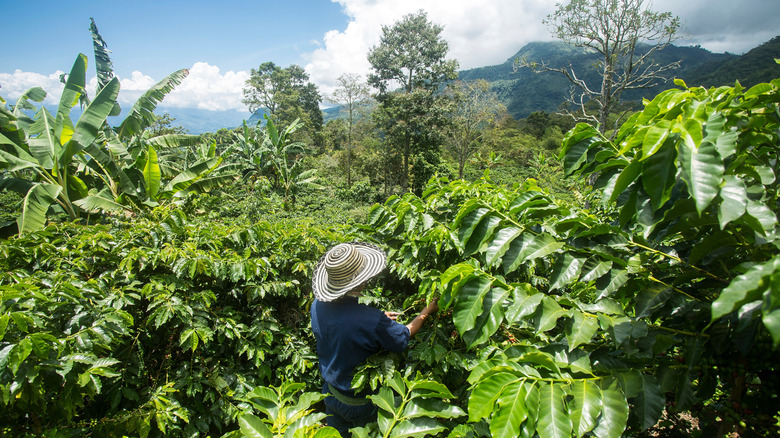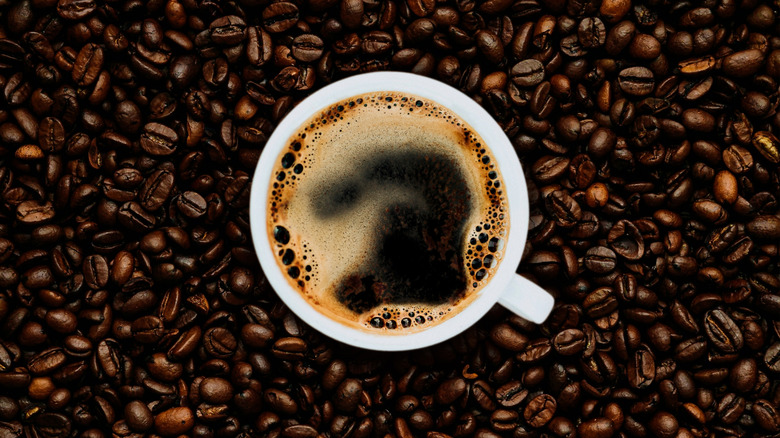The Complex History Behind Colombia's Love For Coffee
Colombia may not produce the most coffee in the world, but it's certainly one of the most famous coffee-producing countries. For Colombians, this beverage is an unofficial symbol of national identity and a great source of pride. But, this wasn't always the case. In fact, coffee wasn't introduced to the area which would become Colombia until the 1700s, and it didn't become widely consumed until a century later. This is because Colombians already had a drink of choice: traditional hot chocolate. Even once coffee gained popularity, many opposed it and saw it as a sign of societal decline. So, how did coffee become intrinsically tied to Colombian culture? The story is more complex than you'd think.
Thought to have originated in Ethiopia , coffee came to Colombia in the bags of Jesuit monks. During the 18th century, people planted the crop in small quantities, brewing its beans as medicine for digestive issues. However, no one really drank coffee for pleasure, nor did they think it could be used as a cash crop. This slowly started to change, and a national market grew. In 1835, Colombia began exporting coffee internationally, officially starting an industry that continues to significantly contribute to the country's economy today. This change happened in part thanks to priests, businessmen, and rich people who emulated European culture, but not everyone was happy about it.
As coffee expanded, it met some resistance
While it's impossible to account for every single factor that contributed to Colombians' changing their perception of coffee, some players stand out. One is Francisco Romero, a priest who famously assigned planting coffee shrubs as part of penitence for local peoples' sins. He did this to grow his own wealth. (Crops made land more valuable, and he was involved in buying and selling farmland.) While getting richer, Romero also inadvertently helped coffee spread around Santander and Norte de Santander, now important coffee-producing regions. Farmers then began noticing that coffee gave them energy and started consuming it more. Simultaneously, savvy business people saw that coffee was popular in other countries and believed in its potential. They marketed coffee as a European drink that was stylish and delicious, but this made the beverage politically divisive.
Coffee houses were popular in Europe, and many members of the Latin American upper class looked to the continent to determine what was fashionable. These people began drinking coffee at social gatherings, feeling modern for consuming a drink that was so distinctively un-Colombian (unlike the "old fashioned" hot chocolate). Others in the upper class were still filled with anti-European sentiment left over from the War of Independence. For instance, in his famed essay, "The Three Cups," José María Vergara y Vergara expresses disgust at the idea of coffee replacing hot chocolate. He (dramatically) paints the switch from hot chocolate to coffee as a social and moral failure.
How coffee won the heart of Colombians
Despite what people like José María Vergara y Vergara may have felt, coffee inevitably began dripping into everyday life. Whether because of its European ties, profitability, or great taste (or a combination of these reasons), coffee slowly started appearing on Colombian tables. Production boomed in the late 19th century, reaching 600,000 sacks in 1870. As coffee farms expanded in size and influence, more and more livelihoods began depending on the crop. This, in turn, changed the culture, as dishes, clothing items, dances, and other traditions started to form around the act of growing coffee. The crop became such a defining part of everyday life in certain regions that in 2011, UNESCO added the "Coffee Cultural Landscapes of Colombia" to its World Heritage List.
Economically, the incorporation of coffee into the Colombian identity has proven lucrative. The country exported over $4.15 billion worth of coffee in 2022. Of course, the domestic market is also strong with most Colombians drinking between 3.3 and 3.7 cups of joe a day. Though we need to see how climate change will affect the world's coffee production (aside from making the drink pricier), for now, we'll bet that Colombian coffee will continue to form a key part of the global market for a long time. As for the country's traditional hot chocolate (which often has cheese stirred into it), it will never be fully replaced in the hearts of Colombians, but coffee has definitely carved a special place for itself in the country's culinary traditions.


